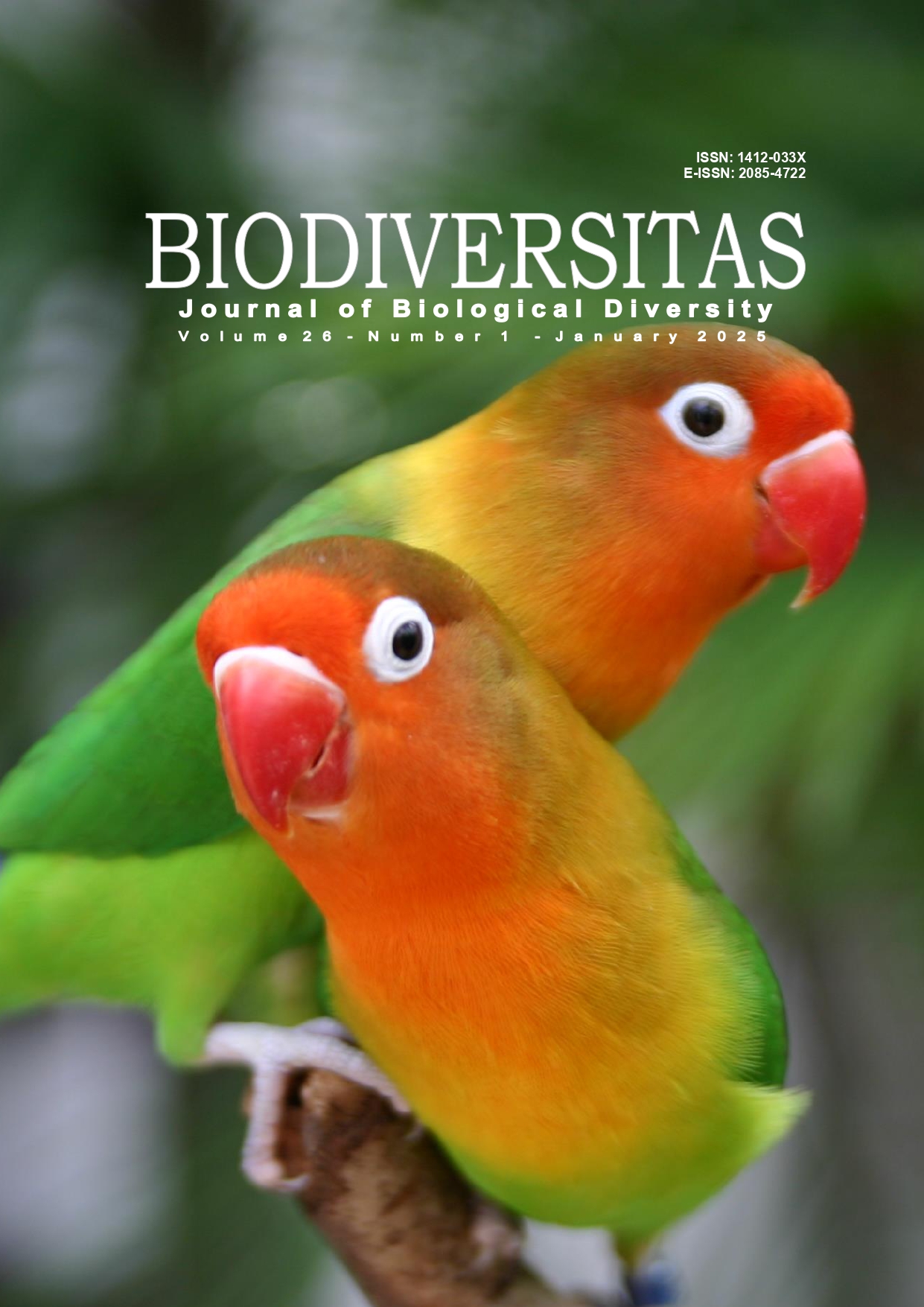Effect of probiotic yeast Pichia kudriavzevii 2P10 and mannan-oligosaccharide on the intestine health of rat infected with Salmonella Typhimurium
##plugins.themes.bootstrap3.article.main##
Abstract
Abstract. Wulan R, Astuti RI, Rukayadi Y, Estuningsih S, Meryandini A. 2025. Effect of probiotic yeast Pichia kudriavzevii 2P10 and mannan-oligosaccharide on the intestine health of rat infected with Salmonella Typhimurium. Biodiversitas 26: 335-344. Recent evidence suggests that probiotic yeast is efficacious against bacterial infections. This study evaluated the effects of dietary supplementation with the live yeast probiotic Pichia kudriavzevii 2P10, Mannan-Oligosaccharide (MOS), and their combination on the growth performance and intestinal health of male Sprague-Dawley (SD) rats infected with Salmonella Typhimurium ATCC 14028 (ST). Two groups were studied: one without ST infection, including P. kudriavzevii 2P10 (PRO), MOS, and their combination (PMOS), and one with ST infection, including CONTROL.ST, PRO.ST, MOS.ST, and PMOS.ST. A diet of 108 CFU/mL PRO and 5% MOS was administered orally for 15 days, followed by a challenge with 108 CFU/mL ST in the ST group. After three days of challenge, the parameters were observed. The findings of this research are that ST infection in rats can cause colonization of ST in the ileum, causing a decrease in white blood cells, necrosis of epithelial cells, and an increased villous-to-crypt ratio (VCR) as a response to inflammation. The administration of PRO, MOS, and their combinations prevents inflammation, as proven by the absence of necrosis and epithelial desquamation. PRO, MOS, and their combinations stimulate intestinal health by increasing villus height, width, and VCR. MOS was found to be the best for increasing lactic acid bacteria. During ST infection, P. kudriavzevii 2P10 can coagulate with ST in the ileum, with this yeast-bacteria binding mechanism allowing free Salmonella Typhimurium cells to bind more to P. kudriavzevii 2P10 cells than to intestinal epithelial cells so that bacterial infection can be prevented. In conclusion, P. kudriavzevii 2P10 administration was the best for stimulating growth performance and intestinal health and preventing severe ST infection in male SD rats, offering promising avenues for further research and potential practical applications in human and animal nutrition and health.
##plugins.themes.bootstrap3.article.details##
Most read articles by the same author(s)
- RAHAYU WULAN, RIKA INDRI ASTUTI, YAYA RUKAYADI, ANJA MERYANDINI, Evaluation of Indigenous Pichia kudriavzevii from cocoa fermentation for a probiotic candidate , Biodiversitas Journal of Biological Diversity: Vol. 22 No. 3 (2021)
- DOVA KELVIN MESRIAN, WIDYA ESTI PURWANINGTYAS, RIKA INDRI ASTUTI, AKHMAD ENDANG ZAINAL HASAN, ARIS TRI WAHYUDI, Methanol pigment extracts derived from two marine actinomycetes exhibit antibacterial and antioxidant activities , Biodiversitas Journal of Biological Diversity: Vol. 22 No. 10 (2021)
- EVRICK YONANTIKO, RIKA INDRI ASTUTI, SRI BUDIARTI, Bacterial community profiles of leaves of wild and cultivated pohpohan (Pilea melastomoides (Poir.) Wedd.) plants based on a metagenomic analysis , Biodiversitas Journal of Biological Diversity: Vol. 25 No. 9 (2024)
- RISA NURSANTY, KHAIRUL NAIM BIN MD PADZIL, NUR ISTI’ANAH BINTI RAMLI, NOR AINY MAHYUDIN, AHMAD HANIFF BIN JAAFAR, YAYA RUKAYADI, Phytochemical analysis of ethanolic Psidium guajava leaves extract using GC-MS and LC-MS , Biodiversitas Journal of Biological Diversity: Vol. 24 No. 5 (2023)
- IRA ERDIANDINI, ARIS TJAHJOLEKSONO, RIKA INDRI ASTUTI, EDI HUSEN, ARIS TRI WAHYUDI, Peat-derived Streptomyces spp. isolated from edamame rhizosphere with plant growth-promoting properties , Biodiversitas Journal of Biological Diversity: Vol. 26 No. 1 (2025)
- NASWANDI NUR, ANJA MERYANDINI, MAGGY THENAWIDJAJA SUHARTONO, ANTONIUS SUWANTO, Lipolytic bacteria and the dynamics of flavor production in Indonesian tempeh , Biodiversitas Journal of Biological Diversity: Vol. 21 No. 8 (2020)
- SINTA AGUSTINA, KOMANG GEDE WIRYAWAN, SRI SUHARTI, ANJA MERYANDINI, The enrichment process and morphological identification of anaerobic fungi isolated from buffalo rumen , Biodiversitas Journal of Biological Diversity: Vol. 23 No. 1 (2022)
- FATURRAHMAN FATURRAHMAN, ANJA MERYANDINI, MUHAMMAD ZAIRIN JUNIOR, IMAN RUSMANA, Isolation and identification of an agar-liquefying marine bacterium and some properties of its extracellular agarases , Biodiversitas Journal of Biological Diversity: Vol. 12 No. 4 (2011)
- IRFAN ANWAR FAUZAN, ANJA MERYANDINI, RONI RIDWAN, RUSLI FIDRIYANTO, NI WAYAN SRI AGUSTINI, DWI ANDREAS SANTOSA, Coupling Indonesian indigenous Citrobacter freundii and Chlorella pyrenoidosa strain on the anode of microbial fuel cell with various substrates , Biodiversitas Journal of Biological Diversity: Vol. 23 No. 5 (2022)

